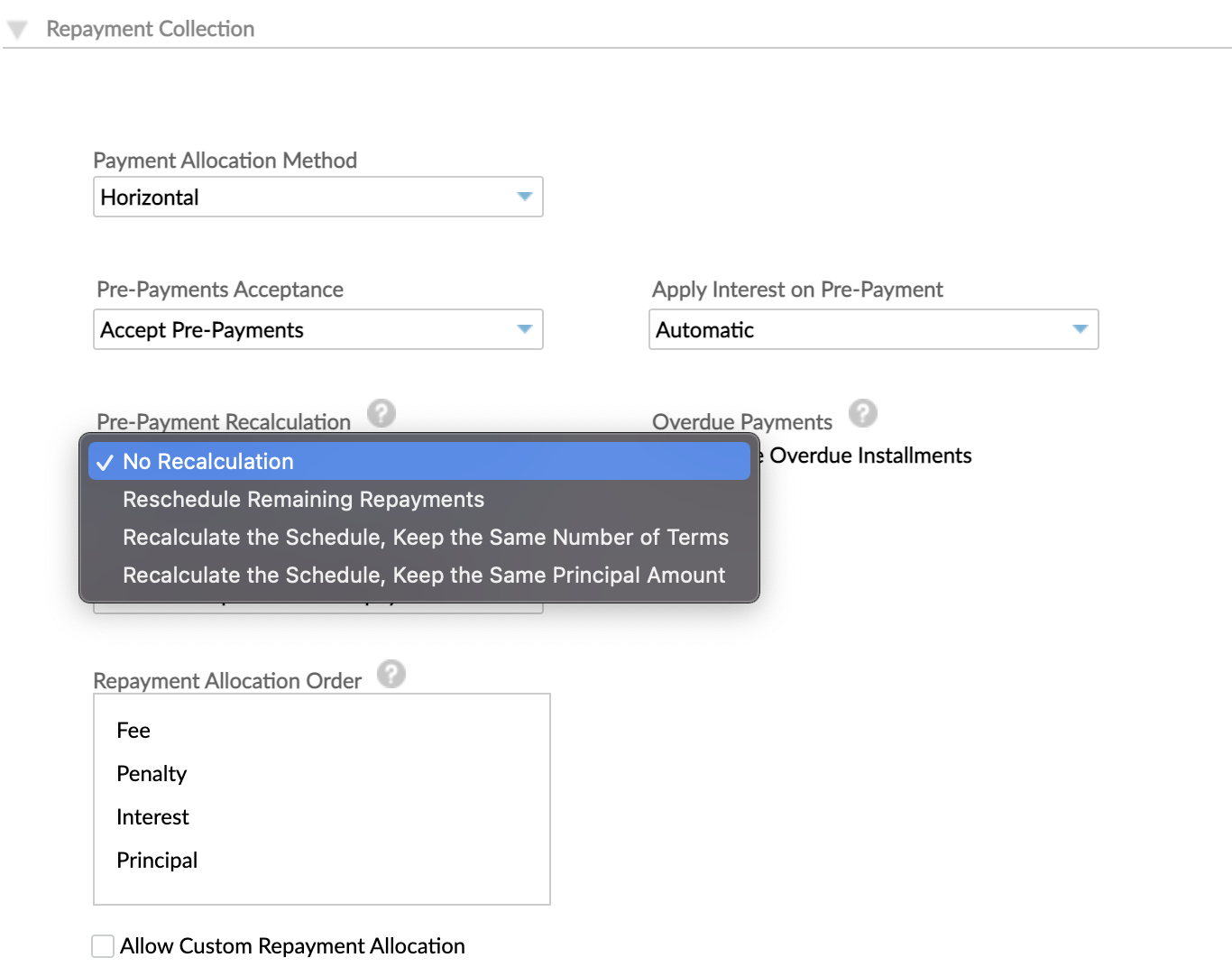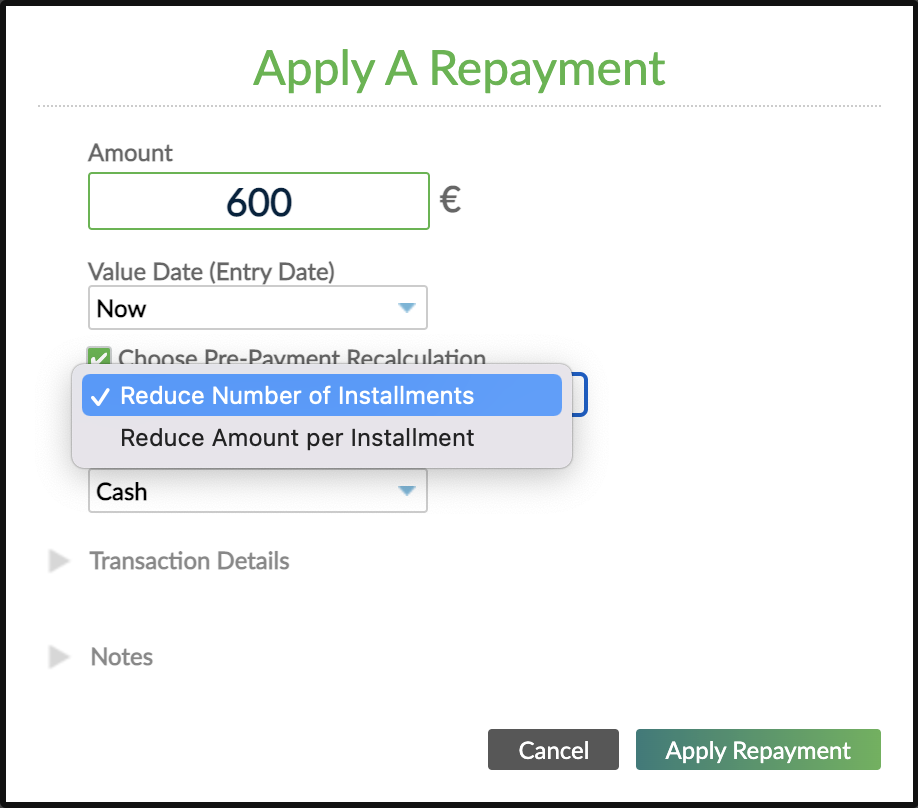- 29 Mar 2023
- 5 Minutes To Read
- Print
- DarkLight
- PDF
Prepayment Recalculation Methods
- Updated On 29 Mar 2023
- 5 Minutes To Read
- Print
- DarkLight
- PDF
When a client makes an early repayment on a loan using the dynamic method, you can choose whether to recalculate the repayment schedule or not.
Mambu supports different recalculation options which you can choose from, based on your internal operations and the interest calculation method used.
Declining Balance
When setting up a new loan product, if under Interest Rate you have chosen the Declining Balance interest calculation method, then in the Repayment Collection section of the form, select one of the following prepayment recalculation methods:
- No recalculation
- Reschedule remaining repayments
- Recalculate the schedule, keep the same number of terms
- Recalculate the schedule, keep the same principal amount

The repayment recalculation method you choose when setting up a new loan product will be applied to all the accounts created under it.
Based on the product setup, this is how the schedule would look like one month after disbursal and without any payments made:

No recalculation
When using this method, there are no changes in the original repayment schedule. The repayments will remain as if the USD600 were paid on the due date.

In the example, both the repayments due in February and March are paid. Without any interest accrued after March 21, the remaining amount will be used to pay the principal of the third installment, the total amount of the principal, and a partial amount of the fourth installment. The remaining installments will still display the same amount as in the original schedule.
Reschedule remaining repayments
When using this method, the expected principal amounts of all the upcoming repayments is reduced equally by the prepaid amount.

In the example, you can see that the first and second repayments are paid. The third installment's principal is also paid and, as there was no interest accrued, the installment is considered as totally paid. The remaining amount will still be used to pay part of the fourth installment's principal. The remaining repayments are recalculated.
Recalculate the schedule, keep the same number of terms
When using this method, where there is an overpayment, the next repayments will be recalculated based on the resulting principal balance.

If instead of an overpayment, there had been a partial pre-payment, the remaining schedule would not be recalculated.
Recalculate the schedule, keep the same principal amount
When using this method, where there is an overpayment, the next repayments will be recalculated based on the resulting principal balance and the repayment is allocated first on the due installments. When the due installments are paid, the number of installments is reduced by allocating the remaining amount on the pending installments at the bottom of the schedule and marking them as paid when the principal expected is covered.

Declining Balance Equal Installments
When setting up a new loan product, if under Interest Rate you have chosen the Declining Balance (Equal Installments) interest calculation method, then in the Repayment Collection section of the form, select one of the following prepayment recalculation methods (Pre-Payment Allocation):
On Next Installments with Mark Installment as Paid When:
- Full Due is Paid (on/after Due Date)
- Principal Expected is Paid (before/on Due Date)
On Upcoming Pending Installment Only with Pre-Payment Recalculation:
- Reduce Amount per Installment (RAI)
- Reduce Number of Installments (RNI)
The repayment recalculation method you choose when setting up a new loan product will be applied to all the accounts created under it.
Next you can see how the schedules would look like for each of the methods, based on the interest calculation method used.
Let's consider the following loan details for the examples:
- Amount: USD1000
- Six installments
- Principal Payment Interval: 1
- Interest Rate: 10% charged per year
- Installments Frequency: Every Month
- Disbursement Date: 21/01/2021
- Today's Date: 21/03/2021
- 360 days in year
Under each recalculation method and each interest method you will see how the repayment schedule would look like for each method, assuming there is a repayment of USD600—knowing the due amount on the 21st of March is just the sum of the first two installments, therefore there will be a pre-payment of the remaining amount.
Based on the same account setup, this is the original schedule for an account using the Declining Balance Equal Installments (DBEI) method.

Prepayment allocation: On Upcoming Pending Installment Only
You have two additional options for allocating prepayments only to the upcoming installment.
Reduce Amount per Installment (RAI)
This method allows for the amount per installment to be reduced when a prepayment is performed, therefore keeping the original number of installments. When making a prepayment, once the principal on the next due installment is covered, it will be marked as paid and the extra interest to be accrued will be recalculated in the next installment. This means that, on the due date, the client only needs to pay a portion of interest.

Reduce Number of Installments (RNI)
This method allows for the number of installments on the account to be reduced when a prepayment is performed. When the prepayment is performed earlier than the expected due date and if the principal amount is covered, then the installment is marked as paid and the remaining un-accrued interest will be recalculated in the next installment. Using this method, the principal due can be reduced to zero.

In the example, the USD600 prepayment is allocated fully on the current installment. In our case the first on the schedule. Since the expected principal was covered, the installment is marked as paid and the remaining interest is recalculated in the next installment. As the repayment amount was considerably higher than what was expected, the last two installments on the schedule are completely reduced.
When entering a repayment greater than the total due, you can choose which prepayment recalculation method you want to use. It can be either Reduce Amount per Installment or Reduce Number of Installments. The impact on the schedule is visible only if you enter an overpayment, meaning, if the repayment is smaller or equal to the total due, there is no impact on the schedule regardless what prepayment recalculation you choose.

If you have a product setup with Reduce Number of Installments and Increase the Last Installment as recalculation methods, you will not be able to choose between Reduce Amount per Installment and Reduce Number of Installments.
Prepayment allocation: On Next Installments
You have two additional options for allocating prepayments on the next installments.
Full Amount Due is Paid (on/after Due Date)
When using this method, the prepayment is allocated to the principal on the current and next installments. However, the current installment will be marked as partially paid, as there remains interest to be accrued until the due date. This means on the due date, the client needs to pay the interest accrued until then.

Principal Expected is Paid (before/on Due Date)
When using this method, the prepayment will be allocated to the principal on the current and next installment. The current installment will be marked as paid and interest is recalculated in the next due installment.



